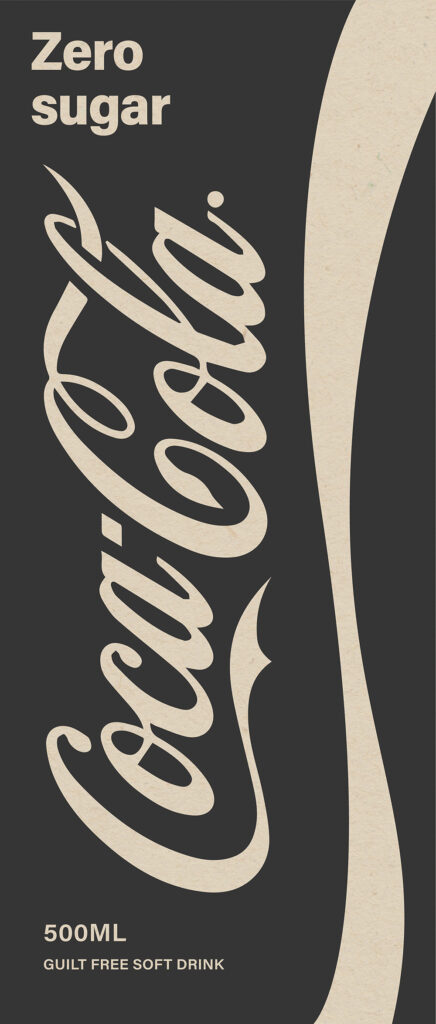Lecture notes
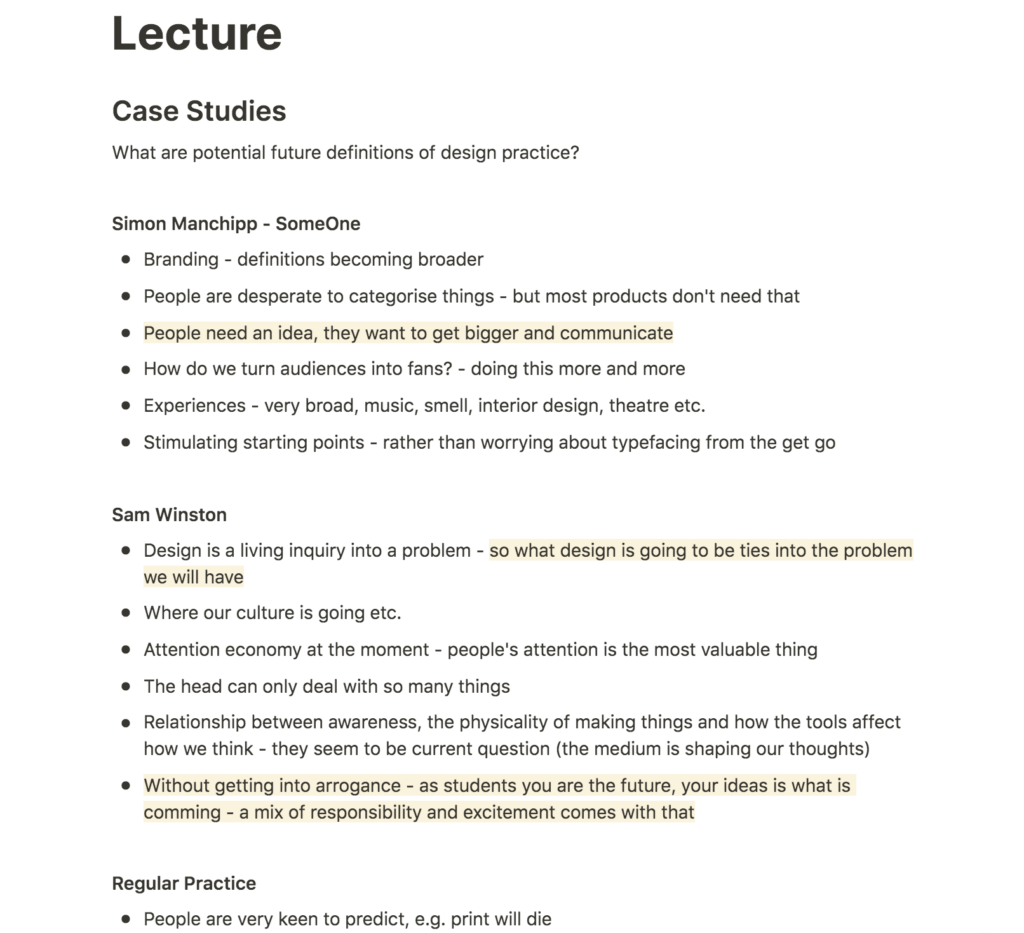
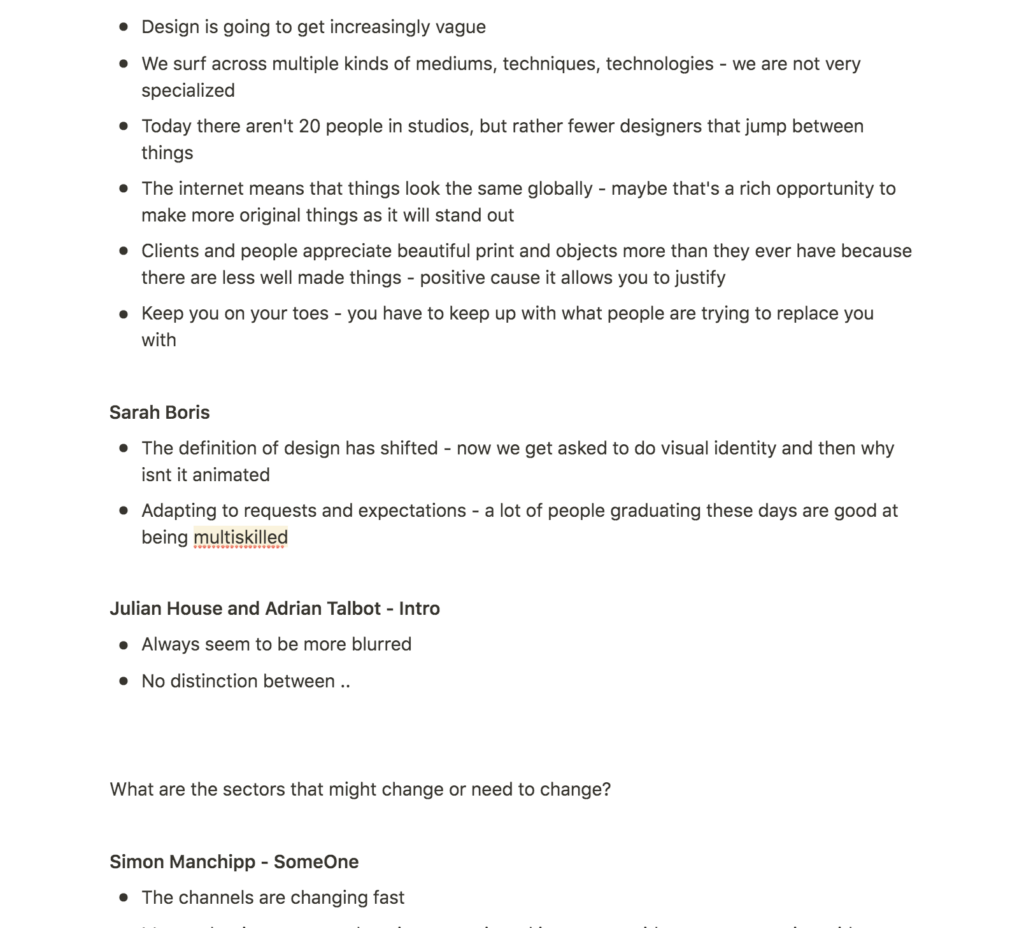
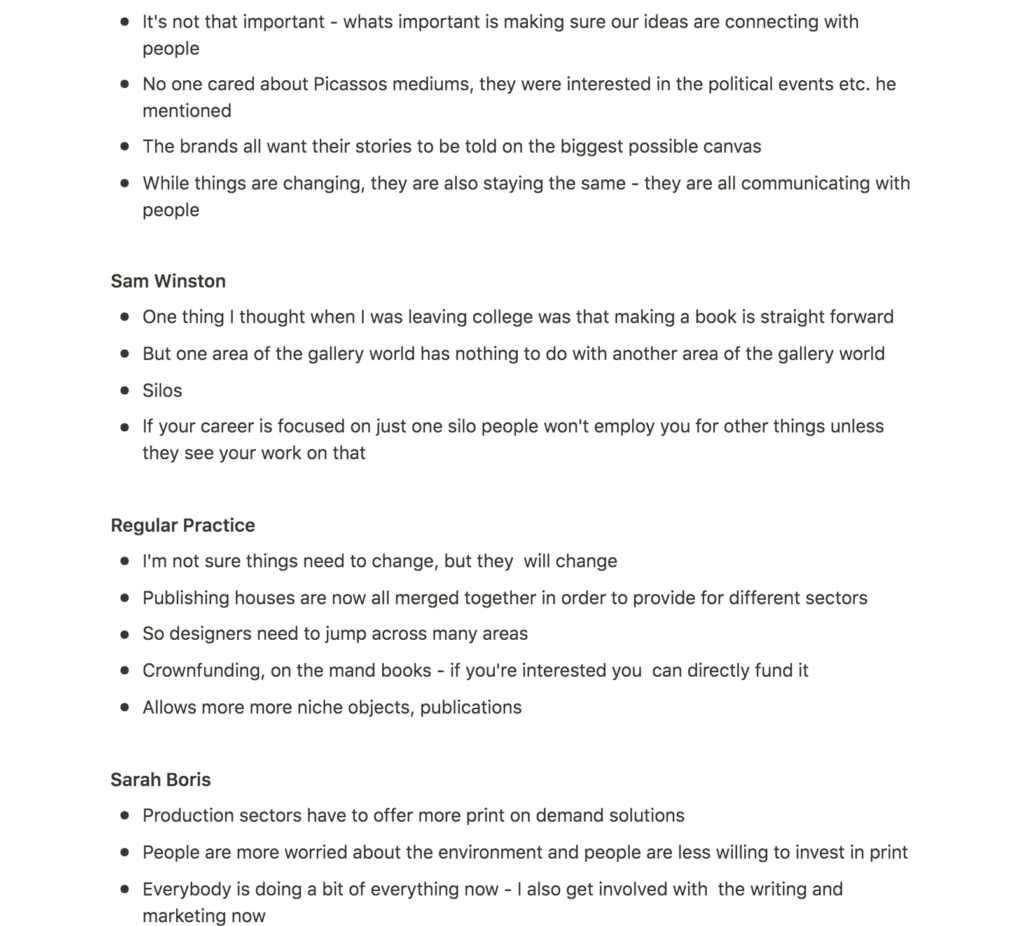
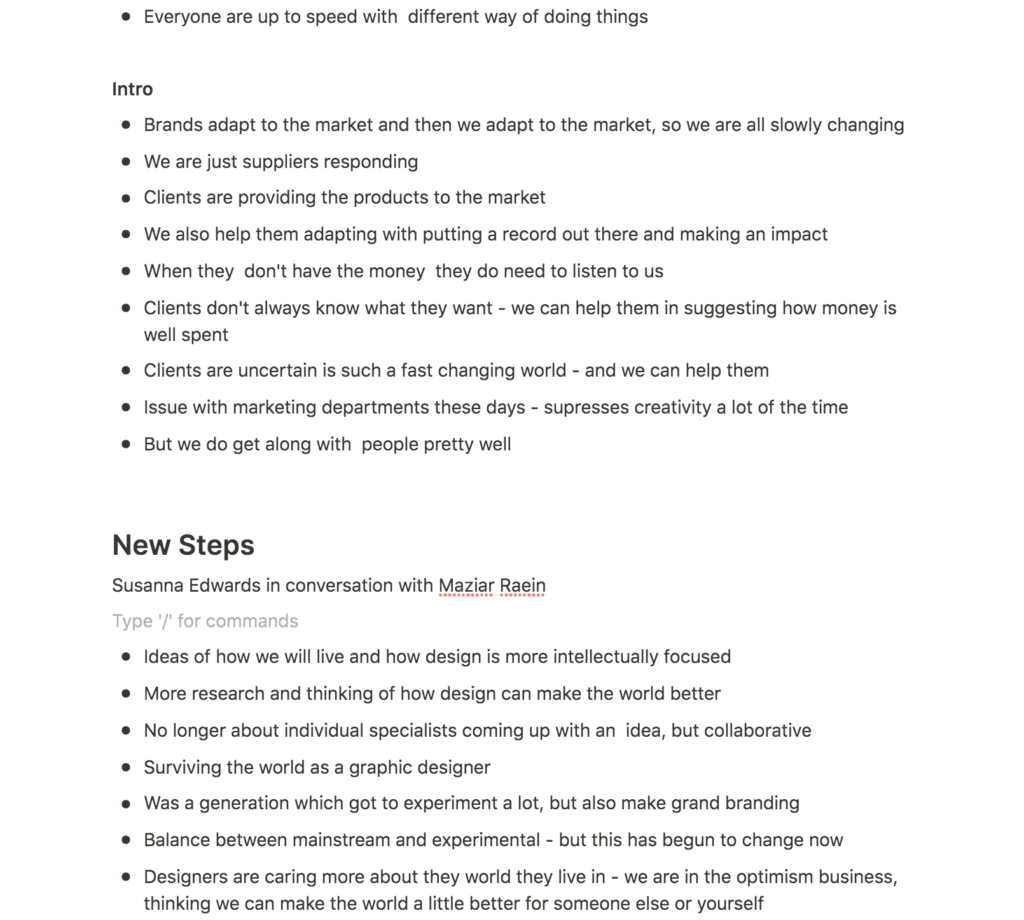
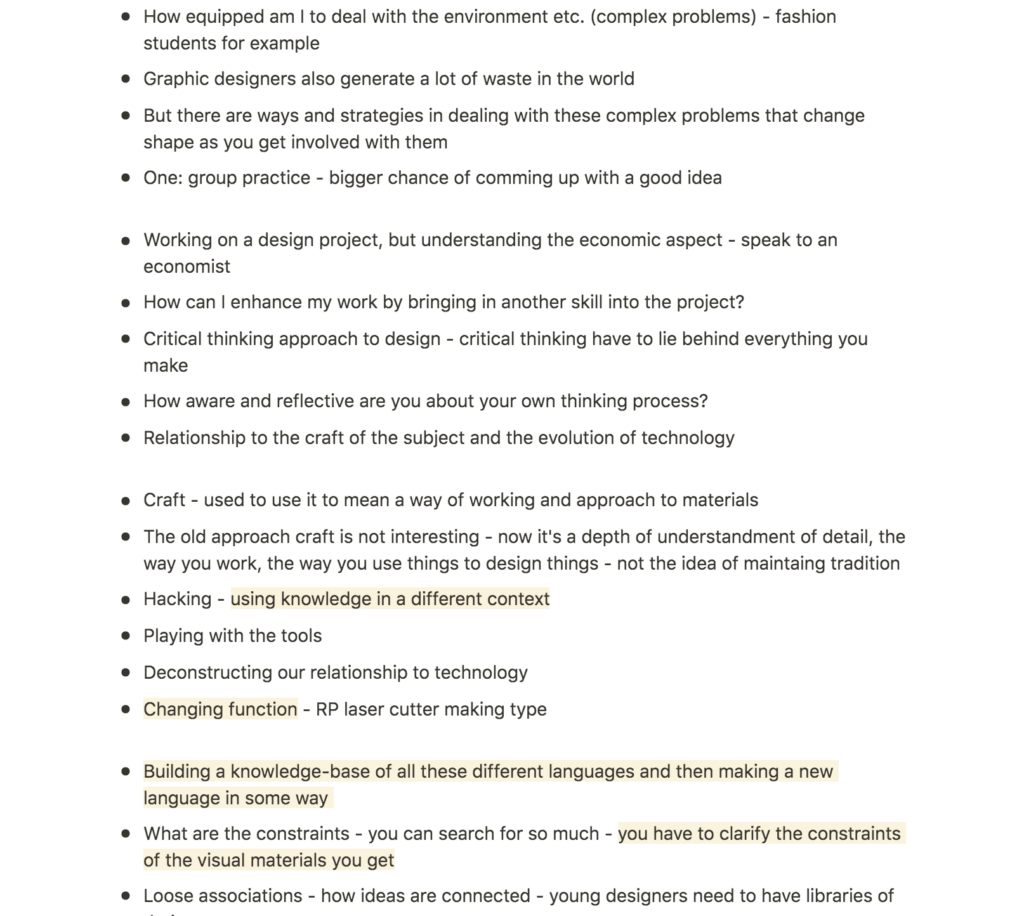
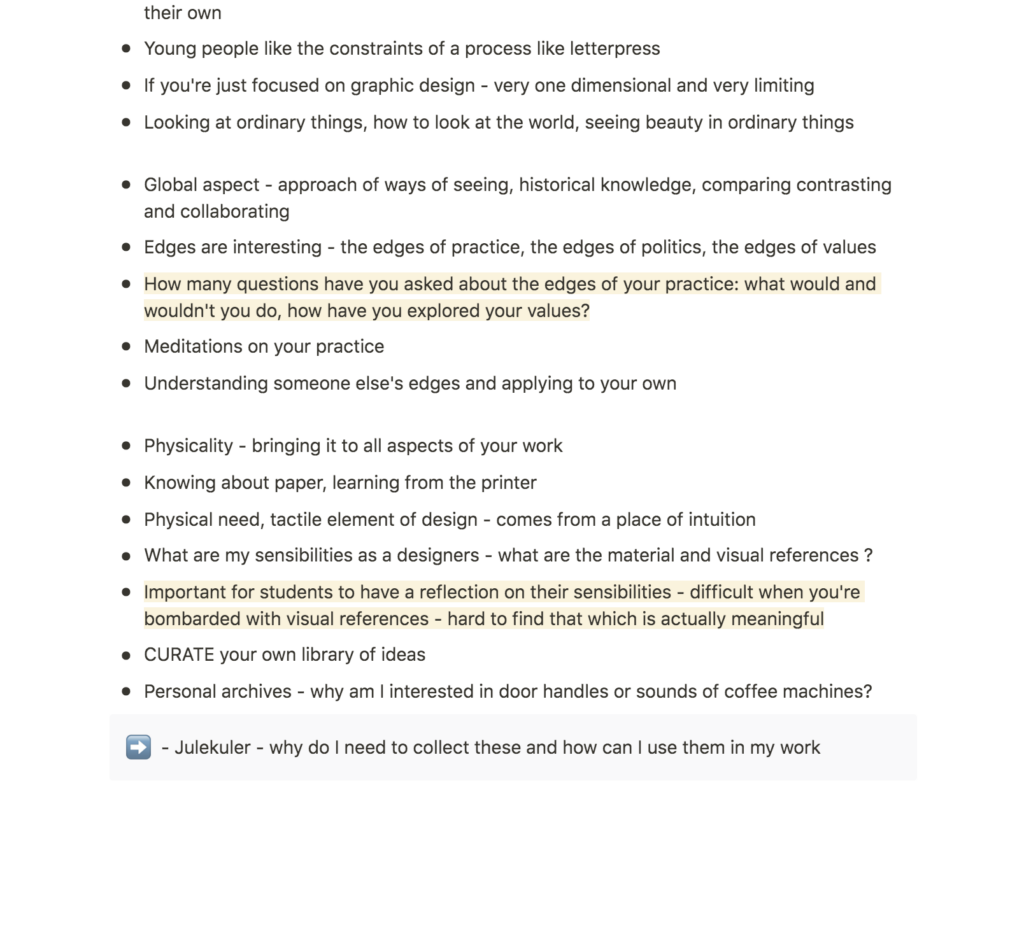
Lecture reflection
Climate change: The essence of our future
I think what Winston mentioned about design being tied to the problems we have, is important when looking at the future of design (Manchipp et al., 2020). The first, and perhaps most obvious problem of our future to me seems to be climate change. Thus, being able to design sustainably innovative solutions will be key. This is nicely linked with Manchipp’s comment that the world will always need good ideas (Manchipp et al., 2020).
As Winston further mentioned, students are the future of design (Manchipp et al., 2020). Therefor it’s important that we do everything we can to design solutions that will make our future a good one. As Raein mentioned, we might then need to gain interests outside the traditional areas of graphic design (Edwards and Raein, 2020). In order to create sustainable solutions, I think we need to understand sustainable principles and learn the biology behind sustainable cycles.
Using knowledge in a different context
In regards to innovation, I was intrigued by Raein and Edward’s discussion on using knowledge in a different context (Edwards and Raein, 2020). At first this seemed a bit intimidating to me, but I think the main takeaway from it, is that we need to explore our curiosity. By approaching something with curiosity, rather than the goal of innovation, I think one is bound to find something that actually excites, rather than something new that is only original because it is different.
How can I curate my visual materials?
I have always been easily excited by things. Whenever I get an idea or see something new, I jump into that with all I have, and although this can be exhilarating, I believe this makes it difficult for me to curate and constrain my visual materials as Raein mentioned (Edwards and Raein, 2020). Perhaps I should attempt to build a sketchbook or digital library in order to ask questions and clarify my preferences, as a way of learning what my focus might be as a designer.
Resource notes
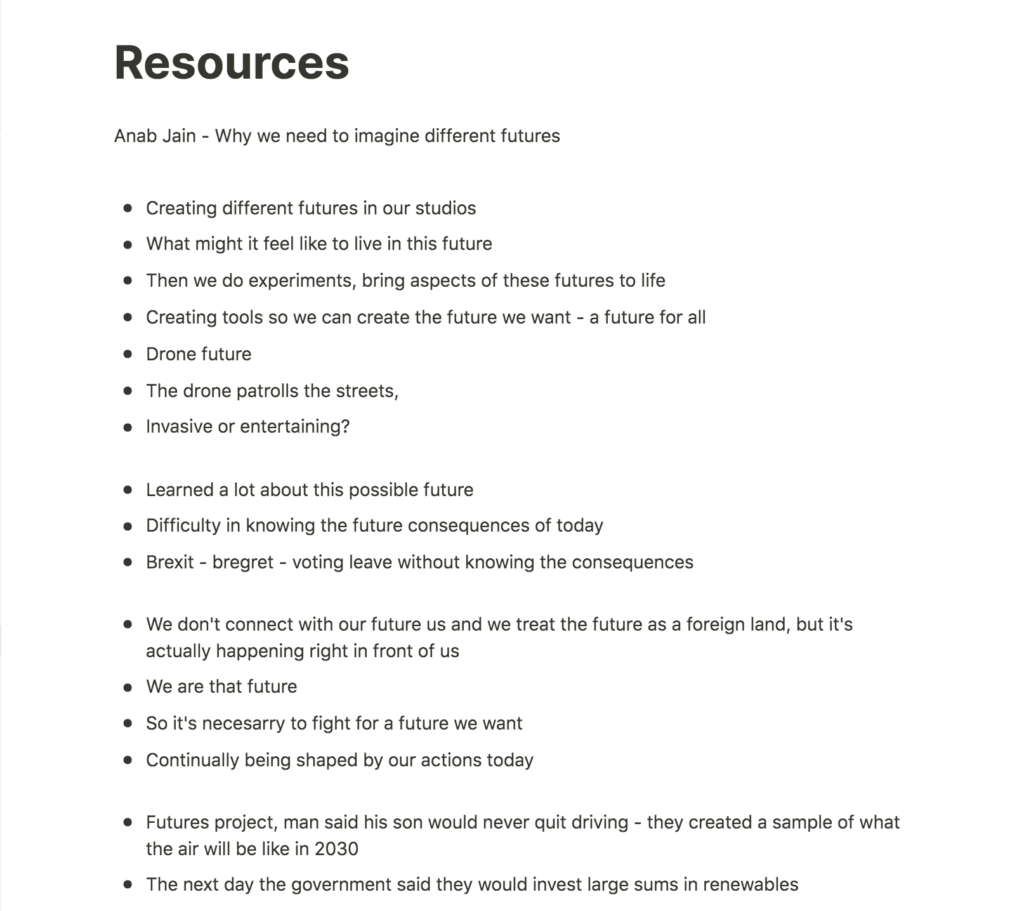
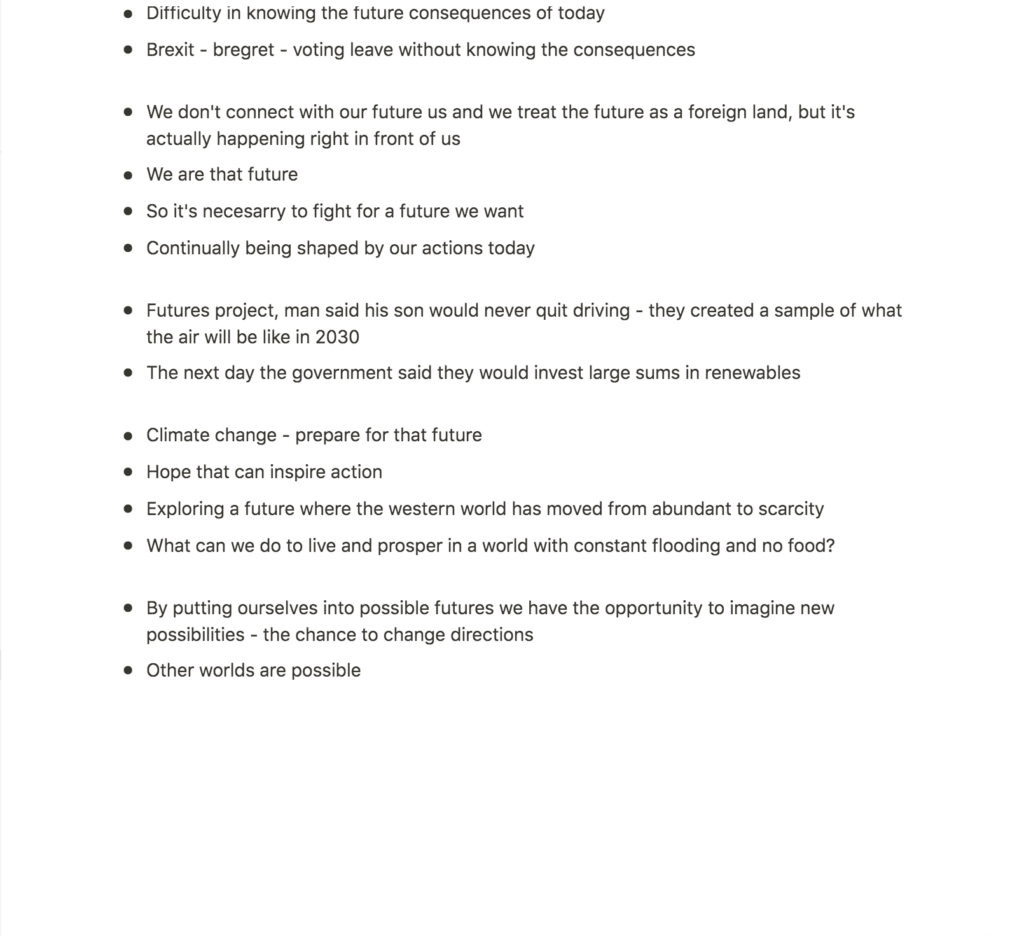
Resource reflection
As mentioned many times on my blog during this module, I am interested in creating sustainable design as I have huge respect for climate change. However, lately I have tried to avoid news and information on what our future might look like as I find it terrifying. I have taken several measures in order to live sustainably and the negative news can therefor feel overwhelming as I already feel like I am doing everything I can.
Seeing Jain’s TED-talk was however quite eye opening in regards to the above. If I want to create sustainable design, I think it might be important that I start confronting myself with the possible futures that lie ahead. For example, Jain’s installation in Saudi Arabia that simulated the air of 2030, changed the government’s minds on investing in renewables. Thus I believe I need to look at ways of persuading people to make sustainable choices, wether that is through installations, branding or campaigns, so that I can try to make a difference beyond my own way of living.
Further research
David Attenborough: A Life on Our Planet
After the reflections above I decided to rewatch A Life on Our Planet, David Attenborough’s recent documentary on Netflix, which amongst other things discusses the future of our planet if we don’t act against climate change, as well as how we can act in order to avoid it.
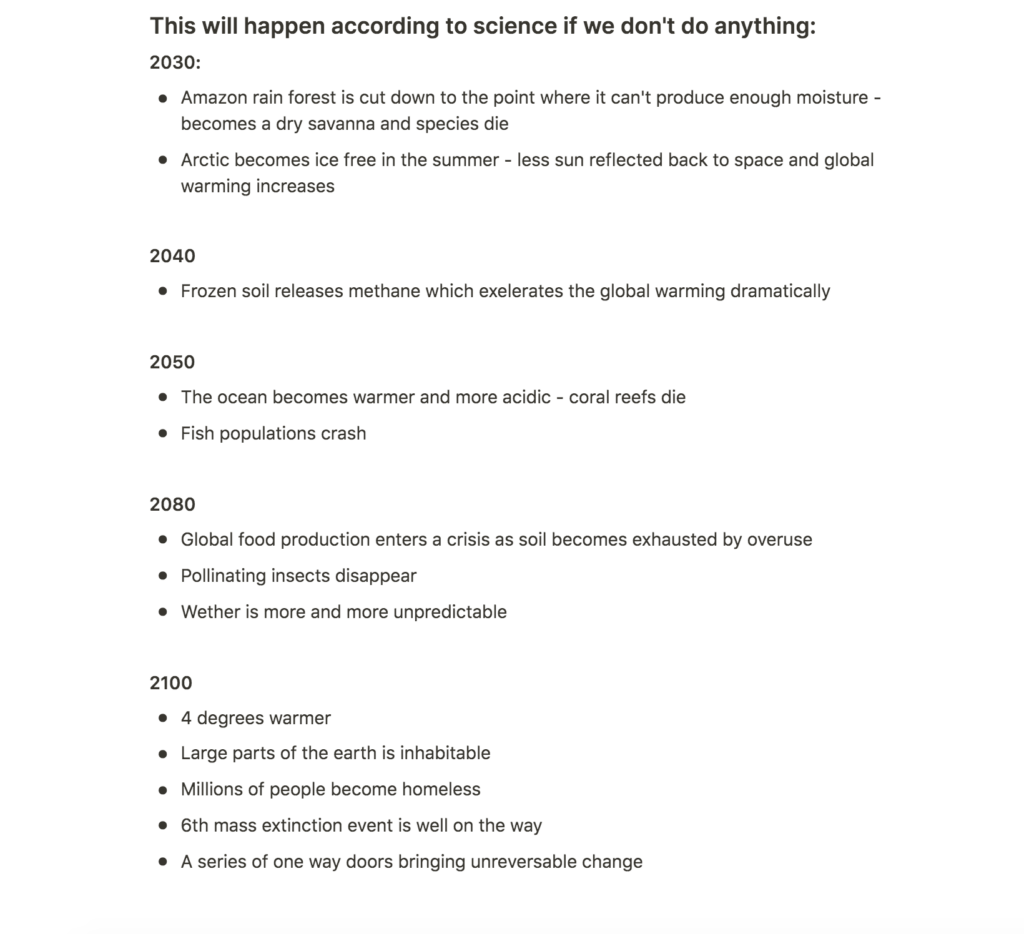
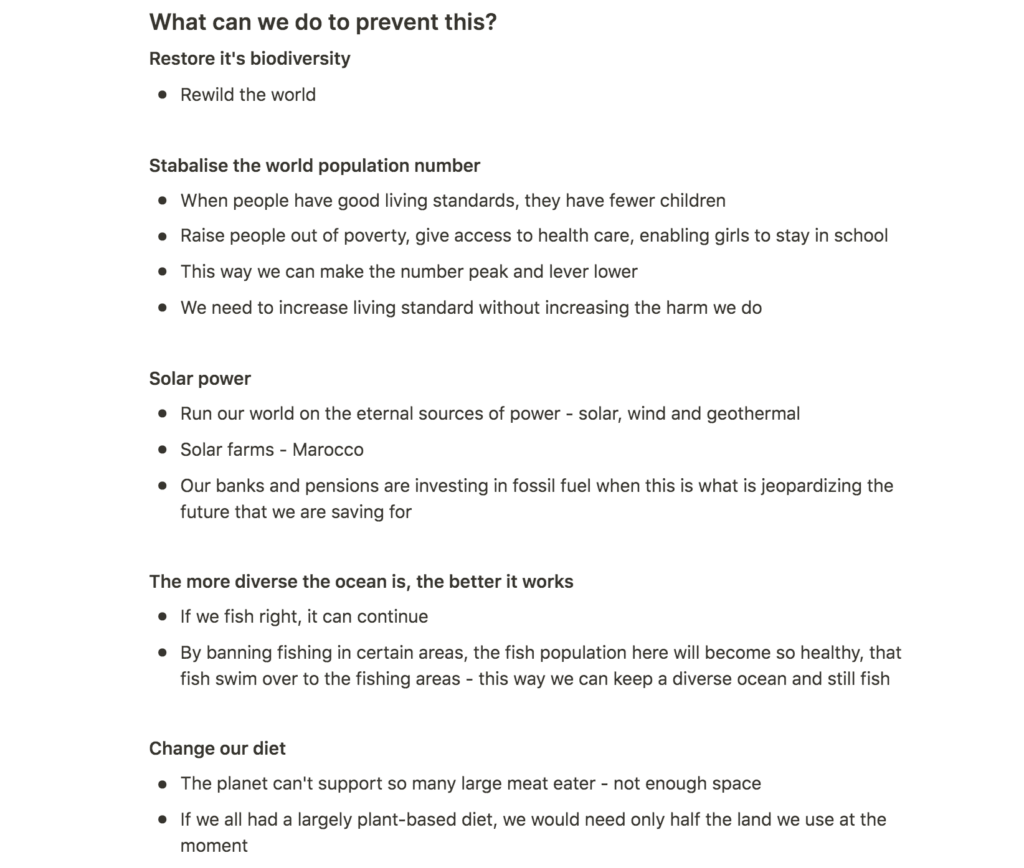
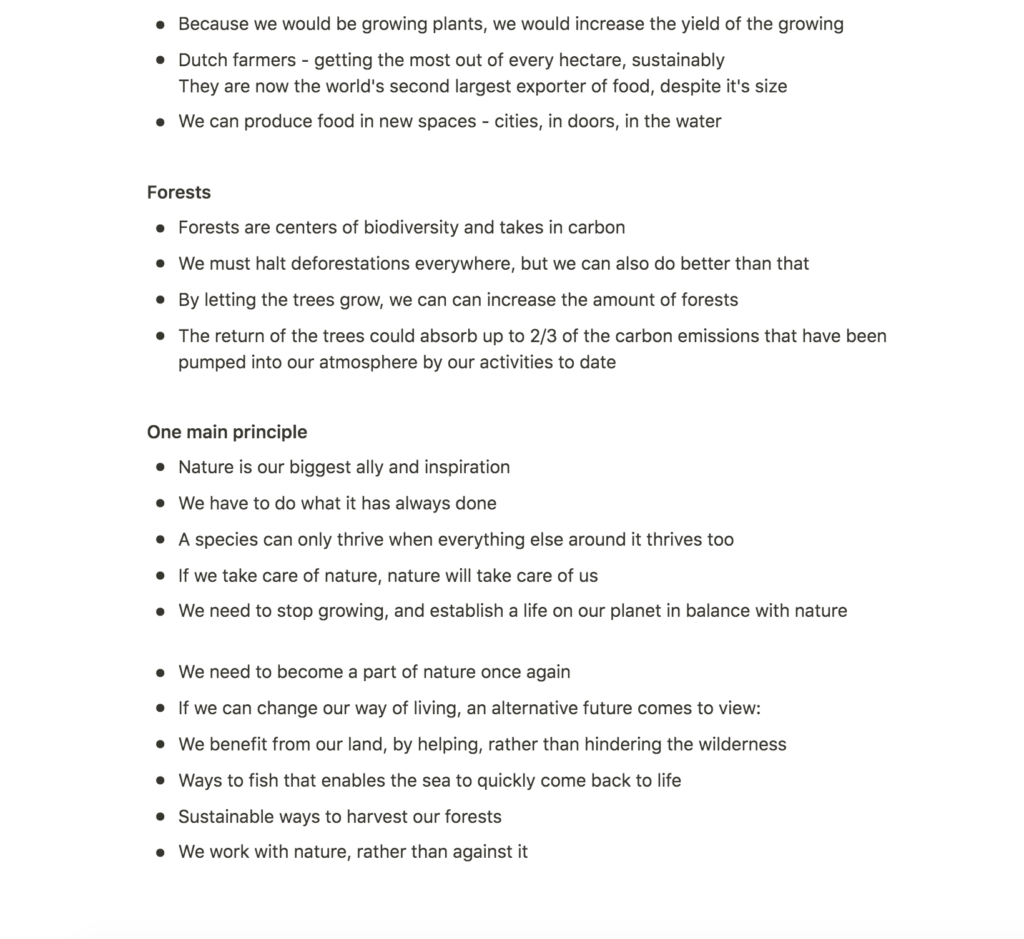
The points of actions were particularly interesting to me, as they later worked as starting points and research for my workshop challenge.
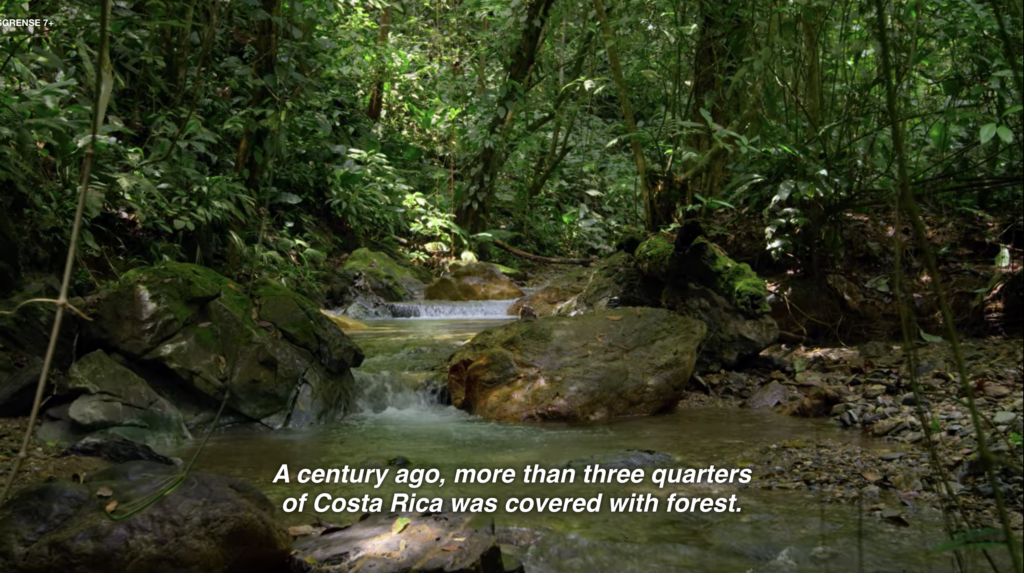
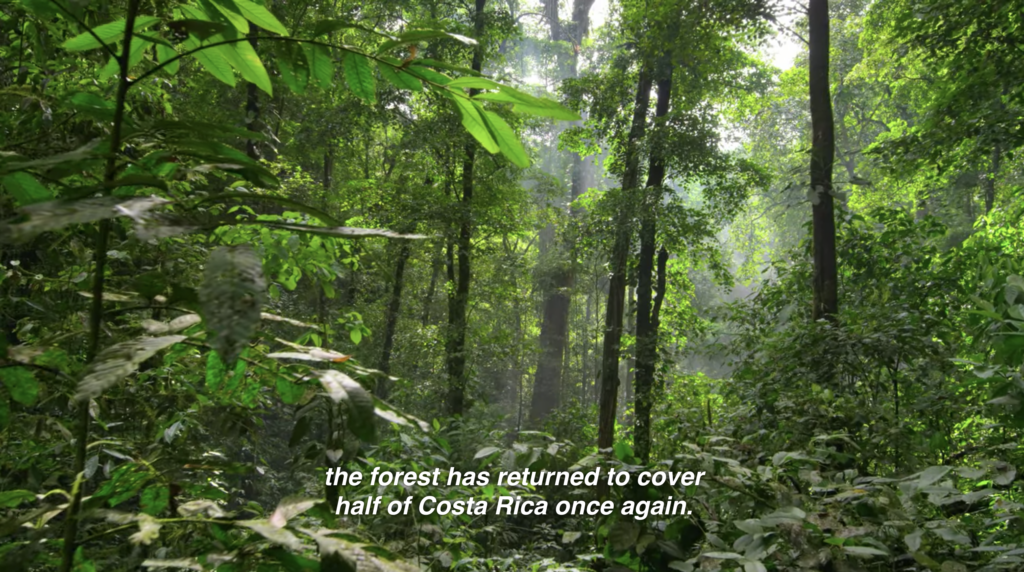
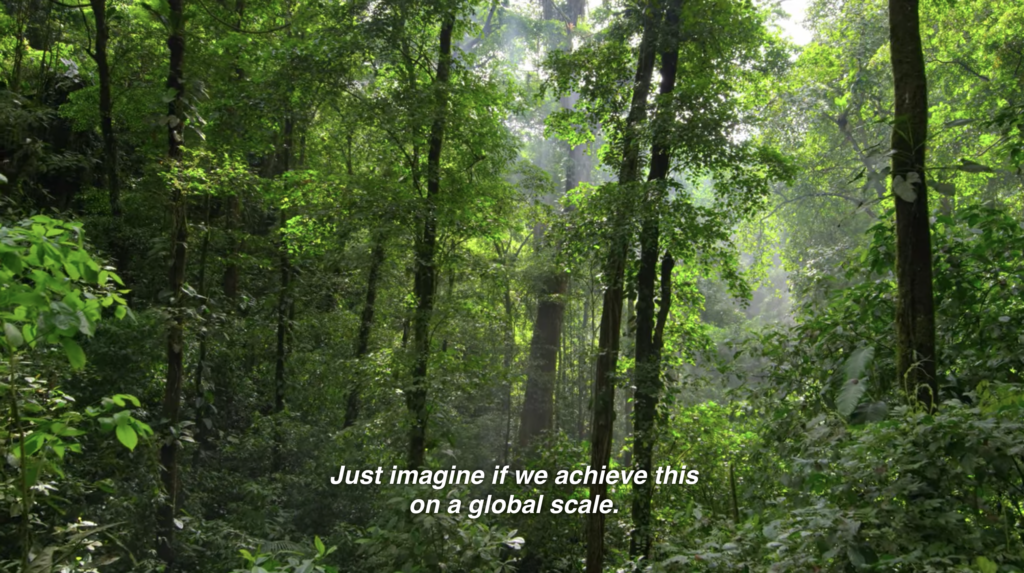
Attenborough’s points of action summed up:
- To stabilise the global human population by increasing living standard for all
- We must use 100% renewable energy sources (hence our banks etc. must stop investing in fossil fuel)
- We must ban certain fishing areas in order to secure a biodiverse ocean
- Our diet’s must become mainly plant based
- We must stop all deforestation and increase the amount of forests further (by doing this trees can absorb 2/3 of all emissions we have pumped out to date)
(Attenborough, 2020). Further, he mentions that we must start helping, and not hindering, wilderness (Attenborough, 2020).
Workshop challenge
Inspired by week 10’s guest lecture with Ophelia Ford-Welman, I decided to briefly imagine what a future world might be if we aim to follow Attenborough’s points. The thoughts I came up with led to three main ideas for the challenge.
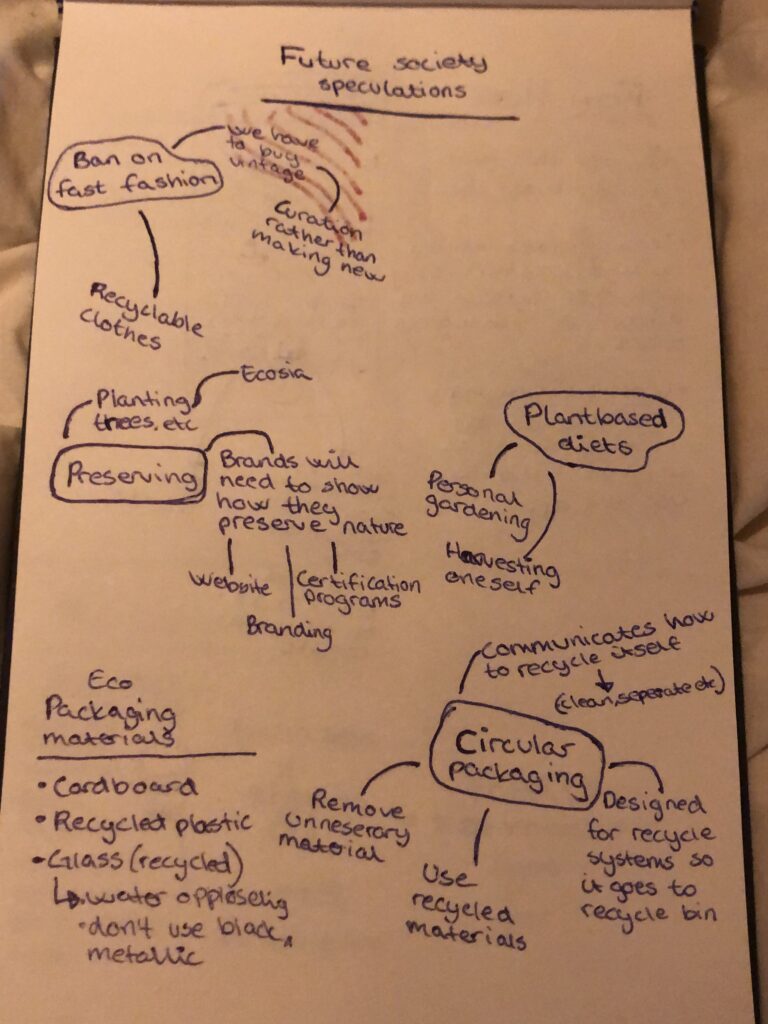
Fish here
Fish here is an idea for an app that explores Attenborough’s point on banning certain fishing areas. By banning certain areas, the amount of fish in these areas will increase to a level where they also enter the non-banned areas, resulting in more fish overall. Fish here would be a GPS-app that would guide fishing boats to certified areas. The app could also hold statistics on good fishing spots based on user data and practical functions like an echo sounder. This app could either be a piece of speculative design for when such a ban happens, or it could be an app that encourages fisher men to avoid certain areas in order to preserve the ocean. I’m assuming this could be effective as long as enough fisher men would use the app.
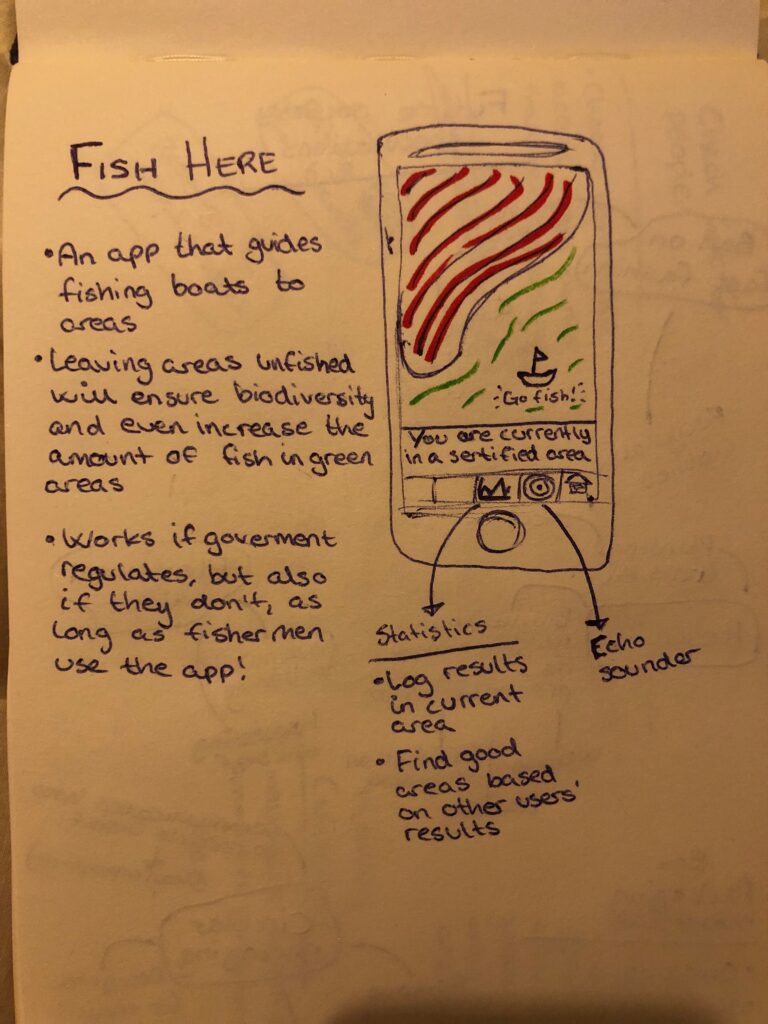
Online platforms that help people live sustainably
Although this probably exists in many shapes and forms already, I think it could be useful to have an easily accessible platform that helps people around the world to live sustainably. The platform could for example consist of to-do lists as a journey towards becoming certified sustainable. The points could be inspired by Attenborough’s points and explain in detail what to do, in everything from changing one’s pension fund to becoming plant based.
Circular packaging
I’m interested in branding and I’m very eager to learn about how brands can continue to live in a sustainable future. In order to learn more about circular and sustainable branding, I had the idea of redesigning the packaging for a big brand. My mind landed on Coca Cola as this is a global brand that would make a big impact if they were to transfer their business model from linear to circular.

I decided to move on with the Coca Cola rebrand idea as this seemed the most manageable within the set time frame. I was also intrigued by the learning potential in this project as I currently have very little knowledge about sustainable materials, but would like to know more.
Grønt Punkt Norge: A library of information on sustainable packaging
Grønt Punkt is a Norwegian certification organisation, whose members promises to take responsibility for the recycling of their distributed products. On their website they have a lot of information on how one can start to create circular packaging.
According to Grønt Punkt, circular packaging have to communicate how it should be recycled (does it need to be taken apart? should it be cleaned?), be designed for recycling (optimise for the recycling system), reduce the amount of material used when possible and use and request recycled material (Grønt Punkt Norge, 2020).
Choosing the material
Through looking at Grønt Punkt’s material guide, glass and paper seemed to be the most sustainable materials for fluids. Glass keeps it’s content fresh, doesn’t loose quality when recycled and doesn’t do danger if thrown into nature (Grønt Punkt Norge, 2020). However, it’s a heavy material which could easily break when shipped globally. Paper cartons can be made with recycled materials, is a light material and can be composted (Grønt Punkt Norge, 2020). Unfortunately it can only be recycled 6-7 times (Grønt Punkt Norge, 2020).

The Coca Cola packaging circle
As I was looking at materials I remembered Attenborough’s point on increasing the amount of trees, as well as his discussions on helping wilderness rather than hindering it (Attenborough, 2020). This made me think that perhaps it could be possible to create a circular system if one where to use paper cartons. Within the short time frame, I have not been able to do thorough enough research to find out if this is physically possible, but it is at least an idea of how companies might work in the future, in order to live in harmony with nature rather than only taking from it.
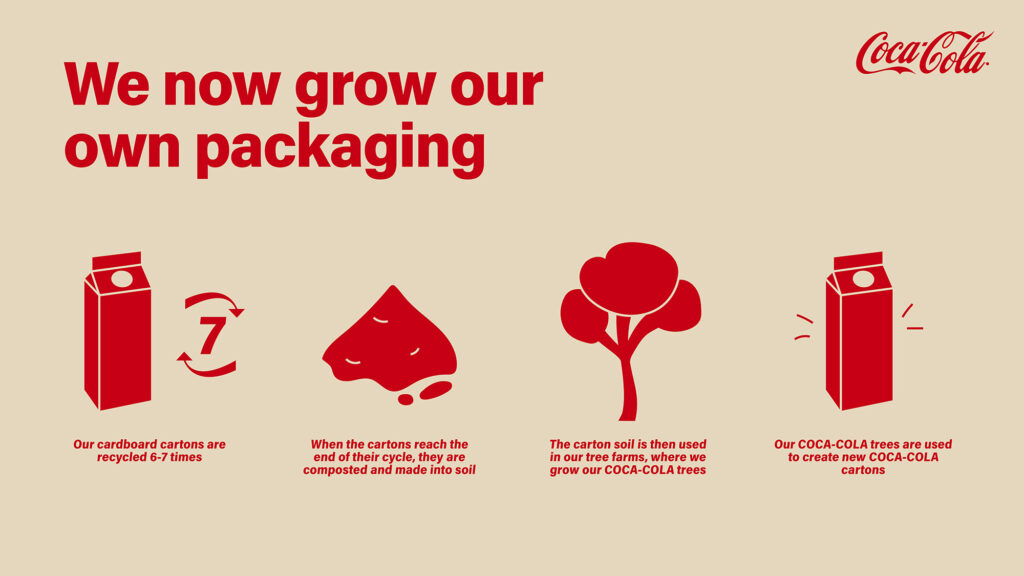
The Coca Cola packaging circle would start with the paper carton. The carton would be recycled 6-7 times, before it would be collected by Coca Cola and used as compost material. The soil from the compost would then be used in Coca Cola’s “tree farm” – their own forest where they would plant trees, which would be harvested cautiously in order to create paper for new cartons, which closes the circle.
Boxed Water
As a quick way of checking wether or not one can use paper cartons for soft drinks, I had a look at Boxed Water. They seem to use a cap made out of trees, which would be beneficial for my design as the packaging already consists of paper from the Coca Cola tree farms. Further, I also found that using a paper carton is beneficial in terms of shipping as it can be flat packed and shipped to local factories, something that Coca Cola already has today.

Result
Although Coca Cola was the brand of choice for this task, my result is rather a piece of speculative design which imagines what the packaging systems of future brands might look like. I thought it was important to maintain Coca Cola’s branding for the paper cartons in order to maintain awareness. Further, the design had to work in a future circular economy where we wouldn’t have access to virgin fossil plastic materials. As our expectations to brands’ values increases, it was also important that the system contributed to something good (in this case forestation).
Designing for the Coca Cola circle
In order to communicate how the carton should be recycled, I have created a guide on the side of it. I’ve also included a reminder on the top which says that the cap should be removed as this part should be recycled as plastic. In terms of typography, colours and visual elements, I have tried to stick to the look of Coca Cola. The logo is rotated like the logo in their can designs. The tree trunk is created with Coca Cola’s iconic wave. In order to save ink I’ve left the white parts natural instead of using bleached paper. This creme colour is also carried on into digital material in order to maintain awareness around the brand’s values. The Zero-carton is grey instead of black in order to ensure that it will be recycled.
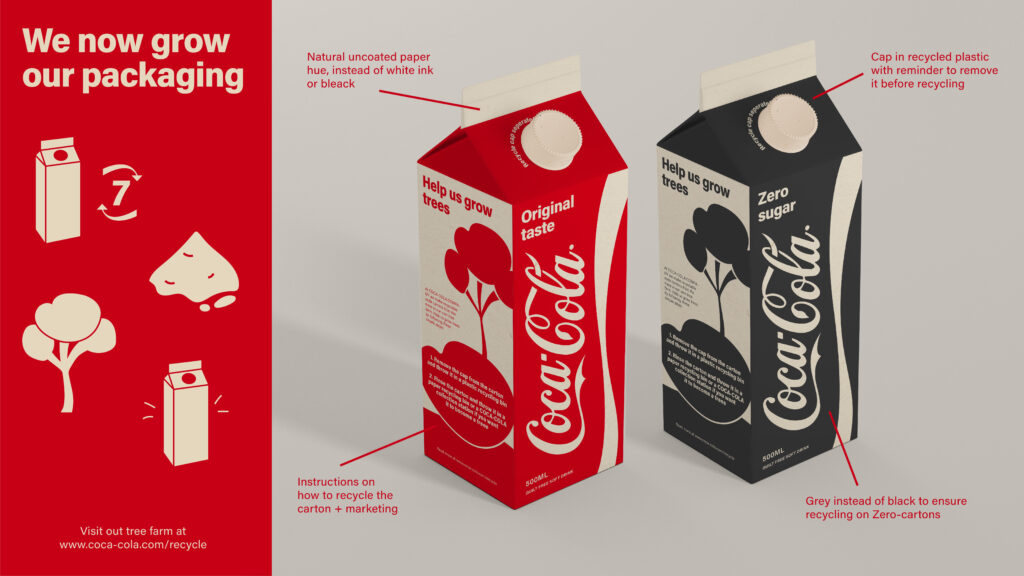
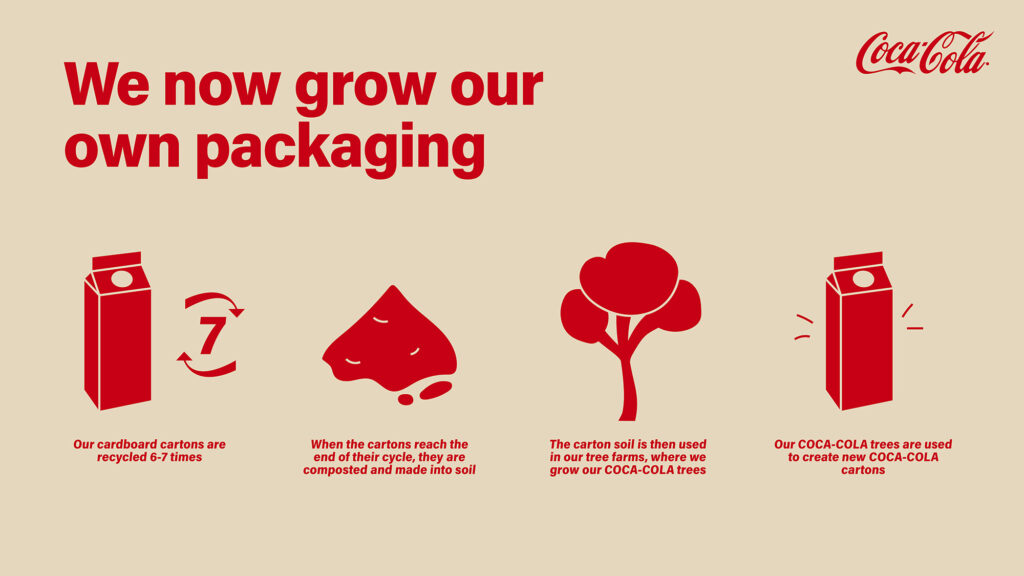
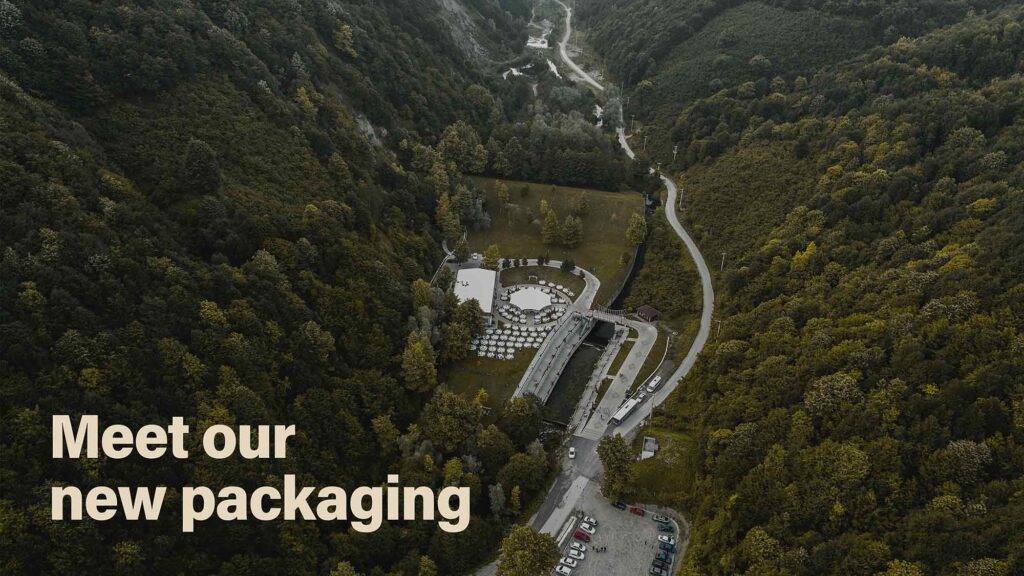
(photograph taken from royalty free website – available at https://unsplash.com/photos/RcIXB09IYBc)
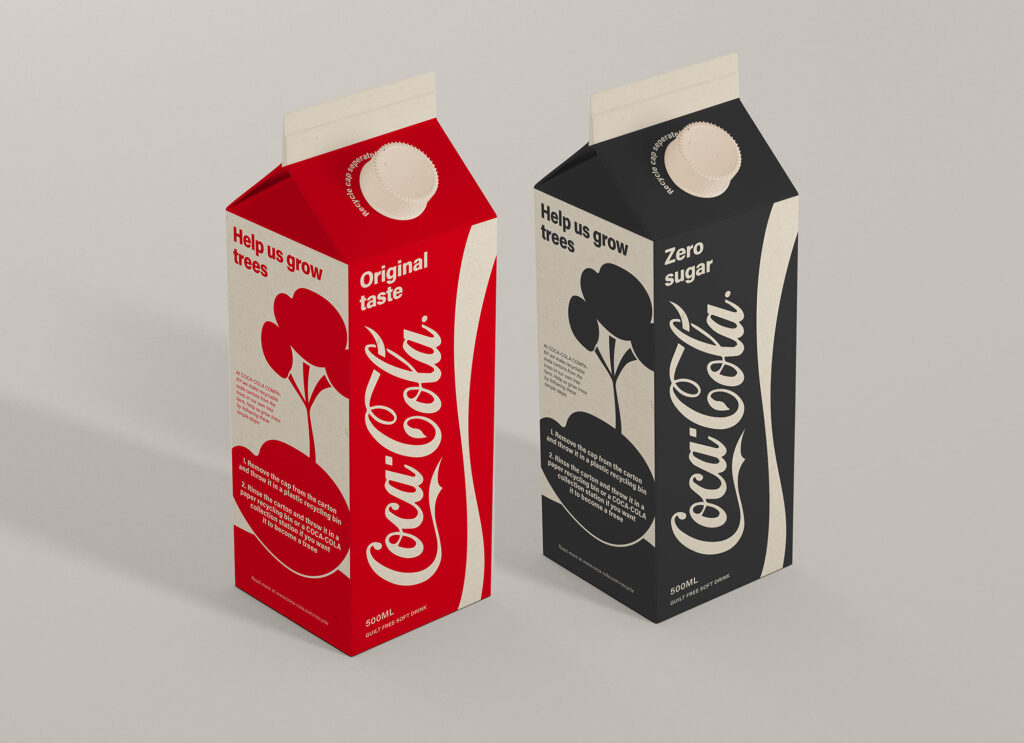
Further investigations
If I had more time, I would have loved to explore the design further, as most of my time this week was spent developing my idea and learning about circular packaging. I would have liked to look at the design for other packaging material as well, like the boxes the cartons would be shipped in. Further it could have been interesting to investigate if there are sustainable options for making the carton more in line with the Coca Cola plastic bottles (and perhaps early day glass bottles) – would it for example be possible to make the logo dented like their current plastic design?
Unfortunately, Piotr also mentioned on the ideas wall that paper cartons can not hold pressurised drinks. Thus, the idea I’ve created this week is not realistic. I would have loved to explore further options if I had the time.
In conclusion
Although this week has been slightly rushed due to deadline week, I have really enjoyed it. Watching Jain’s TED-talk inspired me to face the possible future of global warming. This would usually make me very anxious, but I think knowing that I would be trying to make something to hinder it, helped a lot. The result was a spring board into lots of new information, like ways of using sustainable materials in packaging.
If I had more time I would have loved to do a more thorough future analyse where I would explore the possibilities of a circular economy, and existing research on what brands will be like in the future. This would probably have given my workshop challenge result a more informed approach. At the moment, the result is very much based on the assumption that our future economy will be circular.
I feel very inspired to bring with me this futuristic approach to design moving forward as I aspire to make design which will benefit the planet. Unfortunately the circular idea I came up with for this week’s challenge was not doable realistically. However, I think the result was a great start of an interesting journey that I hope to continue, by perhaps eventually adding a very small part to the future of sustainable graphic design.
REFERENCES:
Attenborough, D. (2020) A Life on Our Planet. Netflix.
Edwards, S. and Raein, M. (2020) ‘New Steps – Susanna Edwards in conversation with Maziar Raein’. Canvas Falmouth Flexible [online], 4 December.
Grønt Punkt Norge (2020) ‘Sirkulær Emballasje’, Grønt Punkt Norge. Available at: https://www.grontpunkt.no/sirkulaer-emballasje/ (Accessed: 7 December 2020).
Jain, A. (2017) Why We Need to Imagine Different Futures. (TED2017). Available at: https://www.ted.com/talks/anab_jain_why_we_need_to_imagine_different_futures (Accessed: 5 December 2020).
Manchipp, S. et al. (2020) ‘What are potential future definitions of design practice? What are the sectors that might change or need to change?’ Canvas Falmouth Flexible [online], 4 December.
LIST OF FIGURES:
Figure 1: David ATTENBOROUGH. 2020. A Life on Our Planet (1) [film still]. Available at : https://www.netflix.com/watch/80216393? [accessed 7 December 2020].
Figure 2: David ATTENBOROUGH. 2020. A Life on Our Planet (2) [film still]. Available at : https://www.netflix.com/watch/80216393? [accessed 7 December 2020].
Figure 3: David ATTENBOROUGH. 2020. A Life on Our Planet (3) [film still]. Available at : https://www.netflix.com/watch/80216393? [accessed 7 December 2020].
Figure 4. Unknown maker. ca. 2015-2020. No title. [photograph with graphic decoration]. Grønt Punkt Norge [online]. Available at: https://www.grontpunkt.no/sirkulaer-emballasje/materialer/drikkekartong/ [accessed 8 December 2020].
Figure 5: Ingrid REIGSTAD. 2020. We now grow our own packaging. Private collection: Ingrid Reigstad.
Figure 6. Unknown maker. ca. 2015-2018. No title. [photograph]. Boxed Water [online]. Available at:https://boxedwaterisbetter.com/blogs/blog/5-reasons-to-drink-boxed-water [accessed 8 December 2020].
Figure 7: Ingrid REIGSTAD. 2020. Coca Cola redesign 1. Private collection: Ingrid Reigstad.
Figure 8: Ingrid REIGSTAD. 2020. Coca Cola redesign 2. Private collection: Ingrid Reigstad.
Figure 9: Ingrid REIGSTAD. 2020. Coca Cola redesign 3. Private collection: Ingrid Reigstad.
Figure 10: Ingrid REIGSTAD. 2020. Coca Cola redesign 4. Private collection: Ingrid Reigstad.
Figure 11: Ingrid REIGSTAD. 2020. Coca Cola redesign 4. Private collection: Ingrid Reigstad.


